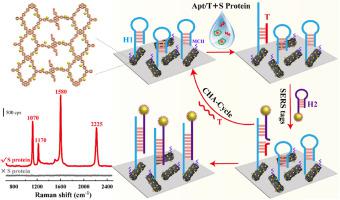当前位置:
X-MOL 学术
›
Anal. Chim. Acta
›
论文详情
Our official English website, www.x-mol.net, welcomes your feedback! (Note: you will need to create a separate account there.)
Sensitivity-improved SERS detection of SARS-CoV-2 spike protein by Au NPs/COFs integrated with catalytic-hairpin-assembly amplification technology
Analytica Chimica Acta ( IF 5.7 ) Pub Date : 2024-06-29 , DOI: 10.1016/j.aca.2024.342924 Qiuwen Huang , Na Zhou , Jiayi Peng , Xuanjiang Zeng , Lijuan Du , Yan Zhao , Xiaojun Luo
Analytica Chimica Acta ( IF 5.7 ) Pub Date : 2024-06-29 , DOI: 10.1016/j.aca.2024.342924 Qiuwen Huang , Na Zhou , Jiayi Peng , Xuanjiang Zeng , Lijuan Du , Yan Zhao , Xiaojun Luo

|
The COVID-19 pandemic, caused by the novel coronavirus, has had a profound impact on global health and economies worldwide. This unprecedented crisis has affected individuals, communities, and nations in diverse manners. Developing simple and accurate diagnostic methods is an imperative task for frequent testing to mitigate the spread of the virus. Among these methods, SARS-CoV-2 antigen tests in clinical specimens have emerged as a promising diagnostic method for COVID-19 due to their sensitive and accurate detection of spike (S) protein, which plays a crucial role in viral infection initiation. In this work, a dual-signal amplification surface enhanced Raman scattering (SERS)-based S protein biosensor was constructed based on Au NPs/COFs and enzyme-free catalytic hairpin assembly (CHA) amplification method. The approach relies on a released free DNA sequence (T), which is generated from the competition reaction between Aptamer/T and Aptamer/S protein, to trigger a CHA reaction. Due to the high binding affinity and selectivity between the S protein and its aptamer, CHA process was triggered with the maximum SERS tags (H2-conjugated Au@4-mercaptobenzonitrile@Ag) anchored onto Au NPs/COFs substrate surface. This SERS platform could detect the S protein at concentrations with high sensitivity (limit of detection = 3.0 × 10 g/mL), wide detection range (1 × 10 to 1 × 10 g/mL), acceptable reproducibility (relative standard deviation = 7.01 %) and excellent specificity. The biosensor was also employed to detect S protein in artificial human salivas. Thus, this study not only developed a novel Au NPs/COFs substrate exhibiting strong SERS enhancement ability and high reproducibility, but also proposed a promising dual-signal amplification SERS-based diagnostic method for COVID-19, holding immense potential for the detection of a wide range of antigens and infectious diseases in future applications.
中文翻译:

Au NP/COF 与催化发夹组装扩增技术相结合,提高 SERS 检测 SARS-CoV-2 刺突蛋白的灵敏度
由新型冠状病毒引起的 COVID-19 大流行对全球健康和世界经济产生了深远影响。这场前所未有的危机以不同的方式影响了个人、社区和国家。开发简单而准确的诊断方法是频繁检测以减轻病毒传播的当务之急。在这些方法中,临床标本中的 SARS-CoV-2 抗原检测因其对刺突 (S) 蛋白的灵敏而准确的检测而成为一种有前途的 COVID-19 诊断方法,而刺突蛋白在病毒感染启动中发挥着至关重要的作用。本工作基于Au NPs/COFs和无酶催化发夹组装(CHA)放大方法构建了基于双信号放大表面增强拉曼散射(SERS)的S蛋白生物传感器。该方法依靠释放的游离DNA序列(T)来触发CHA反应,该序列是由Aptamer/T和Aptamer/S蛋白之间的竞争反应产生的。由于S蛋白与其适体之间的高结合亲和力和选择性,CHA过程是通过锚定在Au NPs/COFs基底表面上的最大SERS标签(H2-缀合的Au@4-mercaptobentile@Ag)来触发的。该SERS平台可以检测浓度高的S蛋白,灵敏度高(检测限= 3.0 × 10 g/mL),检测范围宽(1 × 10至1 × 10 g/mL),重现性可接受(相对标准偏差= 7.01) %) 和优异的特异性。该生物传感器还用于检测人造唾液中的S蛋白。 因此,本研究不仅开发了一种具有强SERS增强能力和高重现性的新型Au NPs/COFs基底,而且提出了一种有前途的基于双信号放大SERS的COVID-19诊断方法,在检测新冠病毒方面具有巨大潜力。未来应用广泛的抗原和传染病。
更新日期:2024-06-29
中文翻译:

Au NP/COF 与催化发夹组装扩增技术相结合,提高 SERS 检测 SARS-CoV-2 刺突蛋白的灵敏度
由新型冠状病毒引起的 COVID-19 大流行对全球健康和世界经济产生了深远影响。这场前所未有的危机以不同的方式影响了个人、社区和国家。开发简单而准确的诊断方法是频繁检测以减轻病毒传播的当务之急。在这些方法中,临床标本中的 SARS-CoV-2 抗原检测因其对刺突 (S) 蛋白的灵敏而准确的检测而成为一种有前途的 COVID-19 诊断方法,而刺突蛋白在病毒感染启动中发挥着至关重要的作用。本工作基于Au NPs/COFs和无酶催化发夹组装(CHA)放大方法构建了基于双信号放大表面增强拉曼散射(SERS)的S蛋白生物传感器。该方法依靠释放的游离DNA序列(T)来触发CHA反应,该序列是由Aptamer/T和Aptamer/S蛋白之间的竞争反应产生的。由于S蛋白与其适体之间的高结合亲和力和选择性,CHA过程是通过锚定在Au NPs/COFs基底表面上的最大SERS标签(H2-缀合的Au@4-mercaptobentile@Ag)来触发的。该SERS平台可以检测浓度高的S蛋白,灵敏度高(检测限= 3.0 × 10 g/mL),检测范围宽(1 × 10至1 × 10 g/mL),重现性可接受(相对标准偏差= 7.01) %) 和优异的特异性。该生物传感器还用于检测人造唾液中的S蛋白。 因此,本研究不仅开发了一种具有强SERS增强能力和高重现性的新型Au NPs/COFs基底,而且提出了一种有前途的基于双信号放大SERS的COVID-19诊断方法,在检测新冠病毒方面具有巨大潜力。未来应用广泛的抗原和传染病。









































 京公网安备 11010802027423号
京公网安备 11010802027423号